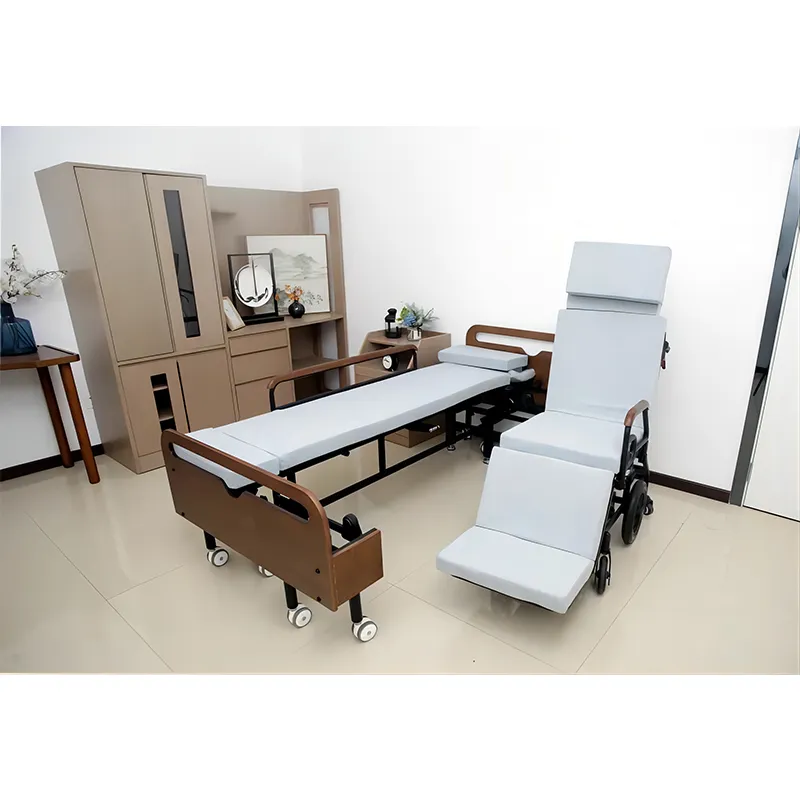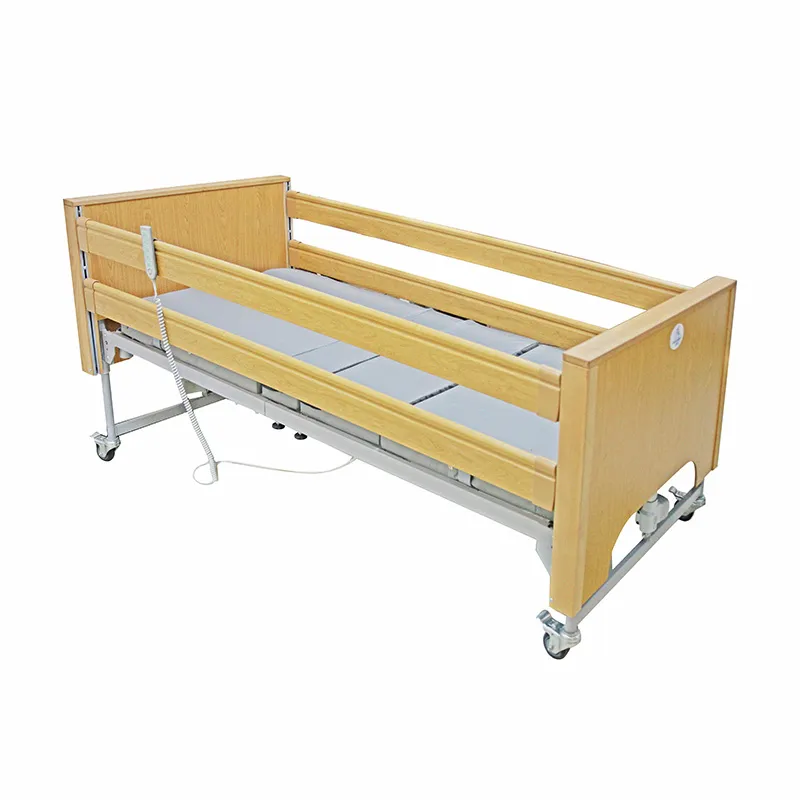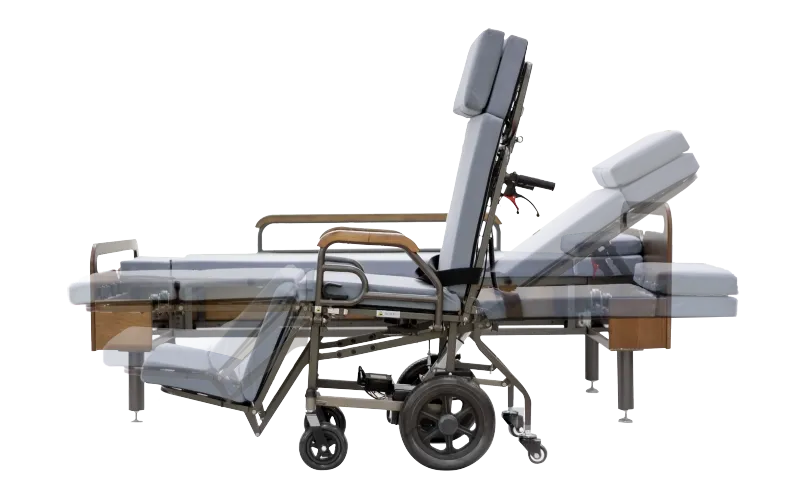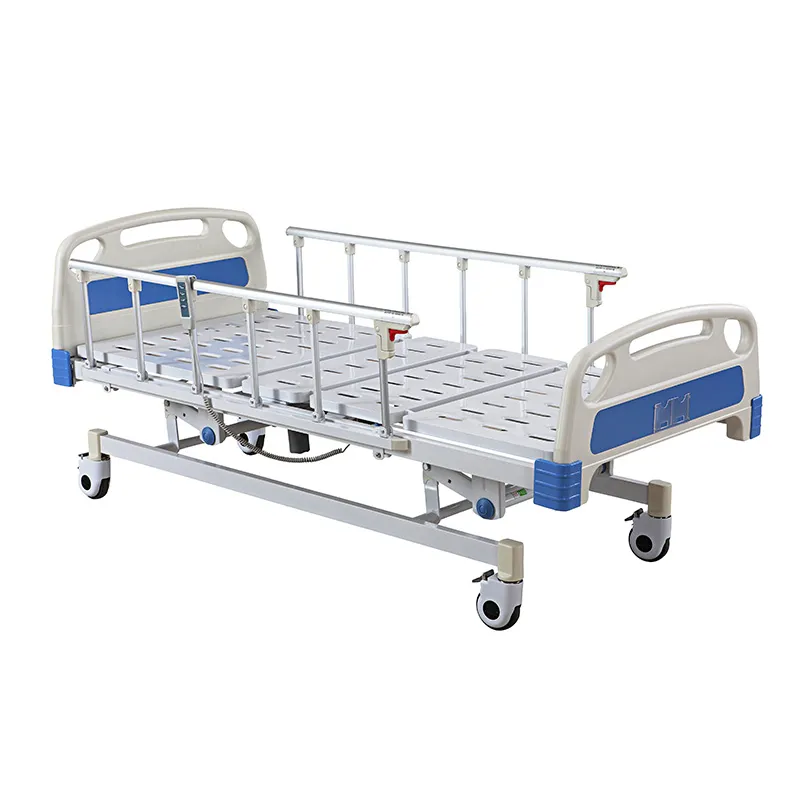
How Do Hospital Beds Help with Spinal Cord injuries?
2024-11-12 15:30
Spinal cord injuries (SCI) are one of the most serious physical injuries, which have a profound impact on patients' physical, psychological and daily life. Whether caused by a car accident, a fall, a sports accident, or certain diseases, the recovery process of spinal cord injuries requires meticulous care, effective rehabilitation therapy, and appropriate medical equipment support. Among all the assistive devices, hospital beds play a vital role.
This article will explore the basics of spinal cord injuries, the care needs of patients, and how hospital beds can help patients with spinal cord injuries recover, and introduce the special bed features that are best suited for patients with spinal cord injuries.

What is a spinal cord injury?
Spinal cord injury is a condition in which the spinal cord is damaged, resulting in loss of sensation, movement, or other functions in the body below the injury site. The spinal cord is an important part of the central nervous system, which transmits information to the brain and other parts of the body through a complex series of neural pathways. Once the spinal cord is damaged, the transmission channel of this information is interrupted, which may cause paralysis, loss of sensation, or loss of control of certain parts of the body.
Spinal cord injuries can be divided into two categories: complete injuries and incomplete injuries. A complete injury means that all sensation and motor function below the injury site is completely lost, while an incomplete injury means that the patient still retains some sensation or motor function. The severity of a spinal cord injury depends on the location and extent of the injury. Generally, the higher the injury site, the greater the paralysis of the body caused.
What are the common symptoms of spinal cord injury?
The symptoms of spinal cord injury vary depending on the location and extent of the injury, and the following are some common symptoms:
● Loss of sensation: After a spinal cord injury, the patient may lose the sense of touch, pain, temperature perception, or other sensations below the injury site.
● Movement disorders: Spinal cord injuries usually cause varying degrees of paralysis. Quadriplegia (four limbs) usually occurs after an injury to the neck, while paraplegia (paralysis of the lower body) is usually caused by injuries to the chest or waist.
● Autonomic dysfunction: Spinal cord injuries may affect the function of the autonomic nervous system, resulting in difficulty regulating body temperature, abnormal heart rate, blood pressure fluctuations, and breathing problems.
● Bladder and bowel problems: Many people with spinal cord injuries experience bladder and bowel dysfunction, leading to incontinence, constipation, or other excretion problems.
● Sexual dysfunction: Spinal cord injury may affect sexual function, including reproductive ability and sexual desire.
● Chronic pain: Some patients experience chronic pain at or below the site of injury, which may be related to nerve damage.
Is there a cure for spinal cord injury?
Currently, there is no complete cure for spinal cord injury, but with advances in medicine and technology, the quality of life of patients with spinal cord injury has improved significantly. Treatment focuses on preventing further damage, promoting recovery, and maximizing the patient's independence. Treatments include surgical intervention in the acute phase, medication, physical therapy, occupational therapy, speech therapy, and psychological support.
Researchers are exploring a variety of potential treatments, such as stem cell therapy, neural regeneration technology, and advanced rehabilitation equipment, although these methods are currently in the experimental stage. In the meantime, the key to improving patients' quality of life lies in providing effective rehabilitation care and assistive device support.

What do people with spinal cord injury need?
The needs of people with spinal cord injury vary from person to person, but generally include the following:
● Physical support: People with spinal cord injury need special physical support to help maintain body posture, prevent bedsores, and promote blood circulation.
● Daily care: Due to the loss of motor and sensory functions, patients may need caregivers to assist with daily activities such as washing, dressing, eating and defecation.
● Rehabilitation therapy: Rehabilitation therapy includes physical therapy, occupational therapy and psychotherapy, which aims to help patients regain as much function as possible and improve their quality of life.
● Psychological support: Spinal cord injury may have a serious impact on the patient's mental health, and psychological support and treatment are essential to help patients adapt to a new lifestyle.
● Medical equipment: Including various equipment such as wheelchairs, mattresses, hospital beds, etc., to help patients adapt to new life needs and prevent secondary injuries.
How do hospital beds help spinal cord injuries?
Hospital beds play an important role in the recovery and care of patients with spinal cord injuries. They not only provide a comfortable resting environment, but also support patients' daily care, rehabilitation training and improvement of their quality of life through a variety of functions. The following are the important roles that hospital beds play in spinal cord injury care:
Provide a comfortable resting environment
Spinal cord injury patients usually need to stay in bed for a long time, so comfort is key. Hospital beds help patients find the most comfortable posture and reduce discomfort and pain through soft mattresses and adjustable bed surfaces.
Prevent bedsores
Patients who are bedridden for a long time are prone to bedsores due to long-term pressure on the skin. The special pressure-relieving mattress and adjustable bed surface equipped in hospital beds can help disperse body pressure and change the patient's position regularly, thereby effectively preventing the formation of bedsores.
Support rehabilitation training
Patients with spinal cord injuries need to undergo a lot of rehabilitation training to restore their body functions as much as possible. The various adjustment functions of hospital beds, such as the lifting of the head and foot of the bed, can help patients with rehabilitation training, such as upper body support, sit-up exercises and transfer training.
Assist in daily care
Due to the limited mobility of patients with spinal cord injuries, daily care such as washing, eating and dressing may need to be done in bed. Hospital beds can adjust the height and angle to facilitate nursing staff to perform nursing operations, and also help patients maintain a comfortable posture when eating and doing other activities.
Enhance safety
Patients with spinal cord injuries need to pay special attention to safety issues when lying in bed. Hospital beds are equipped with guardrails, non-slip mattresses and emergency call systems to help prevent patients from accidentally falling or slipping, providing additional safety protection.

What special features of hospital beds are beneficial to patients with spinal cord injuries?
The design and function of hospital beds directly affect the rehabilitation effect and quality of life of patients with spinal cord injuries. Here are some hospital bed features that are particularly beneficial to patients with spinal cord injuries:
Electric adjustment
The electric adjustment function allows patients and caregivers to easily adjust the height of the bed, the angle of the head and foot of the bed. This not only helps patients find the most comfortable position, but also assists them in daily activities and rehabilitation training. Electric adjustment also reduces the physical burden of caregivers, making nursing operations easier and safer.
Memory function
Some high-end hospital beds are equipped with a memory function that can save patients' commonly used posture settings. By adjusting to a preset comfortable posture with one click, patients can reduce the trouble of adjusting the bed position and get a better quality of rest.
Automatic turning function
For patients with spinal cord injuries, maintaining the same posture for a long time can easily lead to the formation of bedsores. The automatic turning function can help patients change their position regularly and reduce the risk of long-term skin pressure. This not only reduces the incidence of bedsores, but also reduces the workload of caregivers.
Air mattress
The air mattress is a specially designed pressure-reducing mattress that automatically adjusts the air bag pressure to disperse the weight of the patient's body and prevent excessive local pressure. This mattress is particularly effective in preventing bedsores from forming, making it an ideal choice for people with spinal cord injuries.
Guardrails and emergency call systems
Hospital beds often come with adjustable guardrails to prevent patients from accidentally falling. In addition, emergency call systems allow patients to quickly contact caregivers when they need help, ensuring safety.
What types of beds are best for people with spinal cord injuries?
People with spinal cord injuries have a variety of needs, so choosing the right hospital bed is essential. Here are a few common types of beds and their pros and cons:
Fully electric beds
Fully electric beds are ideal for people with spinal cord injuries because they feature electric adjustment, which allows them to control the height, head, and foot angles of the bed. Patients can adjust the bed position themselves using a remote control, which increases their autonomy and comfort.
Semi-electric beds
Semi-electric beds have electrically adjustable head and foot positions, but height adjustment requires manual operation. Although less expensive, caregivers may need to exert extra physical effort to adjust the height, which is less convenient than fully electric beds.
Low-position beds
Low-position beds are designed to be close to the ground, reducing the risk of injury if patients fall out of bed. For people with spinal cord injuries who are at risk of falling, these beds provide an extra layer of safety.
Specialized rehabilitation beds
Specialized rehabilitation beds are equipped with advanced features such as automatic turning, air-cushioned mattresses and memory functions. Although more expensive, these features can significantly help patients with severe spinal cord injuries recover.

Are there other assistive devices besides hospital beds that can help?
In addition to hospital beds, people with spinal cord injuries can benefit from a variety of assistive devices to help them better adapt to their daily lives and rehabilitation needs:
Wheelchairs
Depending on the needs of the patient, manual or electric wheelchairs can be chosen. Electric wheelchairs are suitable for people with limited mobility, providing more independence and mobility.
Mobility aids
Equipment such as transfer machines and lifting chairs can help patients safely transfer between beds and wheelchairs, bathtubs, etc., reducing the pressure on caregivers.
Special mattresses
Equipment such as pressure-relieving mattresses and air-cushioned beds can reduce the risk of skin pressure and prevent the formation of bedsores.
Adaptive furniture
Adaptive furniture such as height-adjustable tables, chairs designed for wheelchair users and kitchen supplies can help people with spinal cord injuries better complete daily activities independently.








